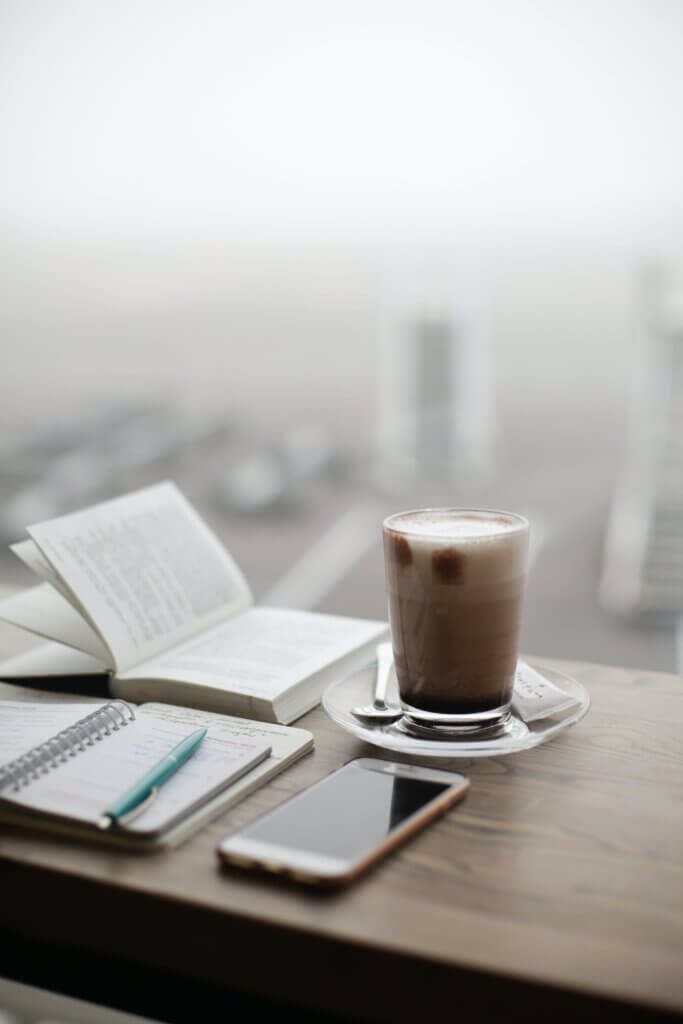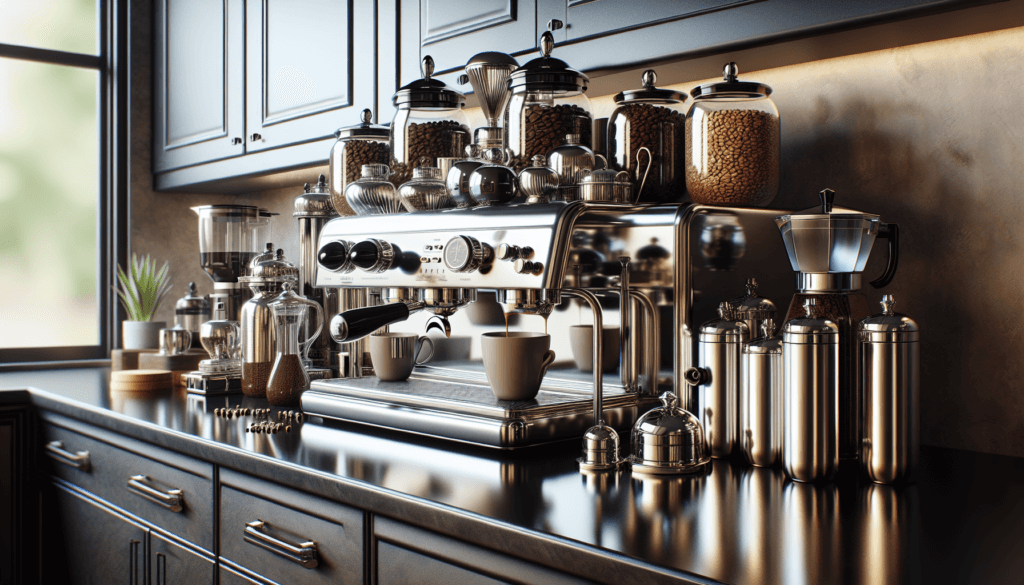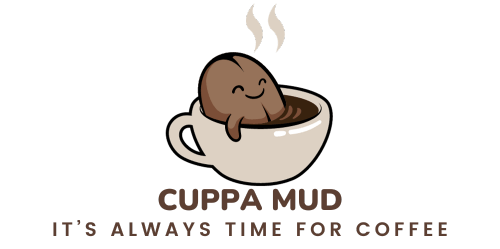So, you’re a coffee lover and you’ve decided it’s time to bring the cafe experience to the comfort of your own home. Setting up your own home coffee bar may seem like a daunting task, but fear not! With a few simple steps and some creative touches, you can transform a corner of your kitchen into a professional-level coffee haven. From selecting the right equipment to organizing your ingredients, this article will guide you through the process of setting up your home coffee bar like a true pro. Get ready to sip on the perfect cup of Joe every morning, without ever having to leave your cozy abode.

1. Choosing the Right Space for Your Coffee Bar
1.1 Assessing the available space in your home
When setting up your coffee bar, the first step is to assess the available space in your home. Look for an area that is conveniently located and easily accessible. Consider the size of the space and whether it will accommodate all the equipment and tools you plan to have in your coffee bar. It’s important to ensure that there is enough room for you to move around comfortably while preparing and serving coffee.
1.2 Considering factors like proximity to the kitchen and electrical outlets
Proximity to the kitchen is an important factor to consider when choosing the right space for your coffee bar. Being close to the kitchen will make it easier for you to access water and other necessary ingredients while brewing coffee. Additionally, consider the availability of electrical outlets in the chosen space. Coffee machines and other equipment require a power source, so having outlets nearby will make it more convenient for you to set up and use your coffee bar.
1.3 Determining the ideal location based on your coffee-making routine
The ideal location for your coffee bar will depend on your coffee-making routine. If you start your day with a cup of coffee, it might be beneficial to set up your coffee bar near where you typically begin your day, such as in the kitchen or in your dining area. On the other hand, if you enjoy a cup of coffee in the evening or after dinner, consider a location that is closer to where you spend your evenings, such as a living room or study area. Base your decision on where you are most likely to enjoy your coffee and create a relaxing ambiance.
2. Selecting Essential Barista Tools and Equipment
2.1 Investing in a high-quality espresso machine
To ensure a pro-level coffee experience at home, investing in a high-quality espresso machine is essential. Look for a machine that offers consistent temperature control, pre-infusion capabilities, and a powerful pump. Consider whether you prefer a manual or automatic machine, as this will affect the level of control you have over the brewing process.
2.2 Choosing a burr grinder for consistent coffee grounds
A burr grinder is a must-have tool for any coffee enthusiast. Unlike blade grinders, which can produce inconsistent particle sizes, burr grinders ensure a uniform grind size, resulting in better extraction and a more flavorful cup of coffee. Look for a grinder that allows you to adjust the grind size and offers a range of settings to accommodate different brewing methods.
2.3 Opting for a precision scale for accurate measurements
Accurate measurements are crucial for a successful coffee brewing process. Investing in a precision scale will help you achieve consistency and precision in your coffee-making. Use the scale to measure the coffee beans, water, and other ingredients accurately, ensuring the perfect ratio for each cup of coffee.
2.4 Acquiring a suitable coffee dripper or French press
If you enjoy pour-over coffee, a coffee dripper or French press is a valuable addition to your coffee bar. Coffee drippers come in various styles, such as V60, Chemex, and Kalita Wave, allowing you to experiment with different brewing methods. Additionally, a French press is a versatile tool that can be used for both brewing coffee and steeping tea.
2.5 Deciding on a milk frother or steaming wand
For those who enjoy milk-based beverages like cappuccinos and lattes, a milk frother or steaming wand is essential. This tool allows you to create creamy and velvety milk foam to top off your favorite coffee drinks. Look for a milk frother or steaming wand that offers adjustable settings, allowing you to achieve the desired texture for your milk foam.
2.6 Considering additional tools like a tamper and knock box
To complete your barista tool collection, consider investing in additional tools such as a tamper and knock box. A tamper is used to evenly compress the coffee grounds in the portafilter before extraction, ensuring even extraction and a flavorful cup of espresso. A knock box, on the other hand, provides a convenient place to dispose of used coffee grounds, keeping your workspace tidy.
3. Coffee Beans and Storage Solutions
3.1 Exploring different coffee bean varieties and flavors
One of the most exciting aspects of setting up a coffee bar is exploring different coffee bean varieties and flavors. Experiment with beans from different regions and countries to discover the unique characteristics and flavors they offer. Consider trying single-origin beans or blends to find your preferred taste profiles.
3.2 Roast levels and their impact on coffee taste
Roast levels significantly impact the taste of your coffee. Lighter roasts tend to have brighter flavors and higher acidity, while darker roasts are characterized by bold, rich flavors with lower acidity. Experiment with different roast levels to find your preferred taste profile.
3.3 Selecting a reputable coffee bean supplier
When it comes to sourcing your coffee beans, it’s important to choose a reputable supplier. Look for a supplier that specializes in high-quality, ethically sourced beans. Consider their roasting methods, freshness of the beans, and customer reviews to ensure you’re getting the best beans for your coffee bar.
3.4 Properly storing coffee beans for freshness
To maintain the freshness and flavor of your coffee beans, proper storage is essential. Store your beans in an airtight container, away from light, heat, and moisture. Avoid storing them in the refrigerator or freezer, as the moisture and temperature fluctuations can negatively impact the beans’ quality.
3.5 Understanding the benefits of whole bean coffee
Whole bean coffee offers numerous benefits compared to pre-ground coffee. When coffee beans are ground, they begin to lose their flavor and aroma much more quickly. By purchasing whole bean coffee and grinding it just before brewing, you can enjoy a fresher and more flavorful cup of coffee.
4. Building Your Coffee Bar’s Workstation
4.1 Designing an ergonomic and efficient setup
When building your coffee bar’s workstation, prioritize ergonomics and efficiency. Arrange your equipment and tools in a way that allows for a smooth workflow. Consider the height of your countertops and the placement of each item to minimize strain and make the coffee-making process more enjoyable.
4.2 Organizing your gadgets, tools, and accessories
Keeping your gadgets, tools, and accessories well-organized is key to a functional coffee bar. Utilize storage solutions such as shelves, drawers, and hooks to keep everything neatly arranged and easily accessible. Consider grouping items by function or frequency of use for added convenience.
4.3 Setting up a dedicated workspace for brewing and serving coffee
To create a professional coffee bar experience at home, designate a dedicated workspace for brewing and serving coffee. This area should be free from other clutter and distractions, allowing you to focus on the art of coffee making. Consider adding a small table or countertop specifically for serving your delicious creations.
4.4 Considering the importance of water quality
Water quality plays a significant role in the taste of your coffee. Consider investing in a water filter or filtration system to improve the quality of the water used in your coffee bar. Avoid using distilled or overly filtered water, as it can result in a flat-tasting coffee. Finding the right balance of minerals in your water can enhance the flavor and aroma of your brew.

5. Creating a Well-Rounded Coffee Menu
5.1 Experimenting with different coffee brewing methods
To offer a well-rounded coffee menu, experiment with different brewing methods. Incorporate options like pour-over, French press, Aeropress, or espresso to cater to different preferences. Each brewing method brings out unique flavors and characteristics in the coffee, allowing you to showcase the versatility of your coffee bar.
5.2 Incorporating various milk-based and non-dairy options
Cater to different dietary preferences by offering various milk-based and non-dairy options. Stock up on dairy milk, alternative milk options like almond, oat, or soy milk, and even non-dairy creamers. This ensures that all coffee enthusiasts, regardless of dietary restrictions, can enjoy a customized cup of coffee at your bar.
5.3 Offering a range of flavor enhancements like syrups and spices
Enhance the flavor profiles of your coffee drinks by offering a range of flavor enhancements. Consider stocking up on flavored syrups like vanilla, caramel, or hazelnut, as well as spices like cinnamon or nutmeg. These additions can elevate the taste of your beverages and provide customers with the option to customize their drinks to their liking.
5.4 Introducing specialty coffee drinks and signature creations
Differentiate your coffee bar by introducing specialty coffee drinks and signature creations. Get creative with unique flavor combinations, add a touch of latte art to your drinks, or create your own signature drink using your favorite ingredients. These special offerings will help you stand out and keep customers coming back for more.
6. Perfecting the Art of Coffee Brewing
6.1 Understanding the coffee-to-water ratio
The coffee-to-water ratio is crucial for achieving a well-balanced and flavorful brew. Experiment with different ratios to find the one that suits your preferred taste. As a general guideline, start with a ratio of 1:16, which means using 1 gram of coffee for every 16 grams of water. Adjust this ratio according to your taste preferences.
6.2 Mastering brewing techniques for different methods
Each brewing method requires specific techniques to achieve the best results. Take the time to master the techniques for each method you offer in your coffee bar. Whether it’s the pour-over technique, French press plunge, or espresso extraction, practice and refine your skills to consistently produce high-quality coffee.
6.3 Nailing the espresso extraction process
To master the art of brewing espresso, pay attention to the extraction process. Ensure that your espresso machine is properly calibrated and set to the right temperature and pressure. Experiment with different grind sizes, tamping techniques, and brewing times to achieve the perfect extraction and a rich, flavorful shot of espresso.
6.4 Achieving the ideal milk texture for creamy beverages
For milk-based beverages, achieving the ideal milk texture is crucial. Practice steaming and frothing techniques to create smooth and velvety milk foam. Pay attention to the temperature and consistency of the milk, as it has a significant impact on the overall taste and texture of the final beverage.

7. Aesthetics and Décor for Your Coffee Bar
7.1 Selecting a theme or style for your coffee bar
Choosing a theme or style for your coffee bar adds personality and sets the ambiance. Consider your personal preferences and the overall vibe you want to create. Whether you prefer a minimalist, industrial, or cozy aesthetic, select furnishings, décor, and colors that align with your chosen theme.
7.2 Choosing the right color palette and materials
The color palette and materials you choose for your coffee bar can greatly influence the overall look and feel of the space. Opt for warm, neutral colors like browns, creams, and blacks to create a welcoming and cozy atmosphere. When it comes to materials, consider incorporating textures like wood, metal, and ceramic to add depth and visual interest.
7.3 Incorporating suitable lighting for ambience and functionality
Lighting is an important element in creating the right ambience and functionality for your coffee bar. Combine ambient, task, and accent lighting to highlight different areas and create a warm and inviting space. Consider using pendant lights, track lighting, or adjustable spotlights to ensure proper illumination at the brewing and serving stations.
7.4 Adding personal touches and decorative elements
Make your coffee bar truly your own by incorporating personal touches and decorative elements. Display coffee-related artwork, posters, or photographs to add visual interest. Consider adding plants, natural elements, or unique knick-knacks that reflect your personality and enhance the overall ambiance of your coffee bar.
7.5 Considering the importance of cleanliness and upkeep
Cleanliness and upkeep are essential for maintaining a professional and inviting coffee bar. Ensure that your workspace is organized and free from clutter. Regularly clean and sanitize your equipment, countertops, and accessories to keep everything hygienic and in top condition. Make cleanliness a priority to provide your customers with a pleasant and enjoyable coffee experience.
8. Understanding the Art of Coffee Tasting
8.1 Learning to evaluate taste, aroma, and body
Coffee tasting, also known as cupping, is an important skill for coffee enthusiasts. Train your palate to evaluate the taste, aroma, and body of different coffees. Focus on distinguishing flavors, noting any acidity or bitterness, and considering the overall mouthfeel of the coffee. This knowledge will allow you to make informed choices when selecting and brewing different coffees.
8.2 Exploring the nuances of different coffee regions
Each coffee region has its own unique characteristics and flavor profiles. Explore the nuances of different coffee-growing regions to expand your coffee knowledge. Pay attention to the terroir, climate, and processing methods associated with each region, as these factors greatly influence the flavors and aromas of the coffee beans.
8.3 Identifying and appreciating flavor profiles
Train your palate to identify and appreciate different flavor profiles in coffee. Tasting notes such as fruity, chocolatey, floral, or nutty can help you describe the flavors you perceive in a particular coffee. Keep a coffee tasting journal to record your observations and develop your sensory skills over time.

9. Continuous Learning and Experimentation
9.1 Reading coffee-related literature and online resources
Stay up-to-date with the latest coffee trends, techniques, and information by investing time in reading coffee-related literature and online resources. Books, blogs, and industry publications can provide valuable insights and help you expand your knowledge and skills as a home barista.
9.2 Participating in coffee workshops and classes
To further enhance your coffee knowledge, consider participating in coffee workshops and classes. Many specialty coffee shops offer hands-on classes where you can learn from experienced baristas. These workshops often cover topics such as latte art, espresso calibration, and manual brewing methods, providing you with practical knowledge and techniques.
9.3 Networking with other coffee enthusiasts
Connect with other coffee enthusiasts to share experiences, tips, and ideas. Join online coffee communities, attend coffee events, or even organize coffee tasting sessions with friends. Networking with like-minded individuals can be fun and inspiring, and it provides an opportunity to learn from one another’s experiences and discoveries.
9.4 Experimenting with coffee recipes and techniques
Embrace experimentation in your coffee bar by trying out new recipes and techniques. Don’t be afraid to think outside the box and create your own unique coffee creations. Incorporate different brewing methods, flavor combinations, or brewing parameters to discover new and exciting flavors. Experimentation is the key to continuous improvement and innovation.
10. Maintenance and Cleaning Tips for Your Coffee Bar
10.1 Regular cleaning of your espresso machine and grinder
Proper maintenance and cleaning of your espresso machine and grinder are crucial for their longevity and optimal performance. Regularly clean the grouphead, portafilter, and steam wand of your espresso machine. Clean the burrs and hopper of your grinder to remove any residual coffee oils and ensure consistent grinding.
10.2 Descaling and maintaining the performance of your equipment
Descaling is an important maintenance task for espresso machines and other coffee equipment. Over time, mineral deposits can build up and affect the performance of your equipment. Follow the manufacturer’s instructions for descaling and perform this task regularly to keep your equipment in top shape.
10.3 Ensuring proper storage and maintenance of accessories
Besides maintaining the coffee equipment, it’s essential to properly store and maintain your coffee bar accessories. Clean and dry them after each use to prevent bacteria growth and maintain their performance. Store accessories like tamper, knock box, and filters in a clean and dry place to avoid contamination or damage.
10.4 Establishing a cleaning routine for a hygienic coffee bar
Establishing a regular cleaning routine is crucial for maintaining a hygienic coffee bar. Clean your workspace, countertops, and serving area daily to remove any spills or residue. Invest in food-safe sanitizers and cleaning agents to ensure the cleanliness of your coffee bar. Regularly washing towels, cloths, and aprons used in your coffee bar is also important to prevent cross-contamination.
Setting up your home coffee bar like a pro requires careful consideration of space, equipment, beans, menu, brewing techniques, aesthetics, ongoing learning, and maintenance. By following these comprehensive steps, you can create a coffee bar that offers a truly exceptional coffee experience in the comfort of your own home. So, grab your favorite coffee beans, get your tools ready, and start brewing your way to barista-level coffee perfection.



